Beyond Old Tales: Folklore and Today's Stories
Folklore connects us across cultures and stories—whether it’s the shadow a young wizard must face in Ursula K. Le Guin’s A Wizard of Earthsea or the lessons my characters discover in Goddess Interrupted and Traditions. This post reflects on how folklore continues to shape characters.
WRITINGFOLKLOREPARANORMALFANTASY
Lisa J Hogan
9/26/20253 min read

Folklore + Writing
Witchy season has arrived, and what better way to kick off than by discussing folklore and its utilization in crafting stories today. So, what is folklore? According to Merriam-Webster’s Dictionary (yes, I still have a physical copy) the definition is: 1. traditional customs, tales, sayings, dances, or art forms preserved among a people. 2. A branch of knowledge that deals with folklore. 3. An often-unsupported notion, stories or sayings that are widely circulated. The term folklore was coined in 1846 by William J. Thoms (1803-1885) a British writer.
Why are these tales still important? Stories teach us who we are, warn us about what to fear, and remind us of what we value. Ancient myths and fairy tales, and even superstitions still shape the way people see the world. Writers can tap into this to deepen their characters, giving them beliefs and traditions that affect the choices they make and the way they understand their lives. When I write my paranormal short stories, folklore becomes a bridge between theme and my characters. It shapes my characters’ decisions and “ah-ha” moments.
Let’s look at one of my all-time favorite novels, The Wizard of Earthsea by Ursula K. Leguin. I still have my yellowed with age copy to refer to. In The Wizard of Earthsea, there are many uses of folklore to help craft the story of Ged and his journey.
Let us start with the magic. The naming magic and true names. This trope appears in several tales, such as the fairytale Rumpelstiltskin. You can find this belief in countless tales: knowing the true name lets you defeat or control the demon. It is Ged’s misuse of this magic in The Wizard of Earthsea that brings about the dark-shadow creature.
Another example is the Shadow. This archetype appears in various folklores and myths. WARNING SPOILER AHEAD. Ged unleashes this “shadow monster” when creating magic that was beyond him and his control. The Doppelgänger, the double, or even hubris would fit this folklore pattern. The idea that oneself is your greatest enemy is used over and over in folklore. An example would be Icarus in Greek mythology. You will also find the Balance of Nature motif, as in the traditions and legends of Native Americans and Polynesian stories. There are also wizards, lore masters, and dragons. All are found in stories told through time.
How have I used folklore in my work? In Goddess Interrupted, I use witches and familiars to tell the tale of how we must find ourselves, and sometimes it cannot be without outside help. In Traditions I use Slavic folktales to bridge generations, the changes in life and in grief. Teaching the importance of handing down stories with love. I use folklore to tell stories about change, acceptance, and love. Both Goddess Interrupted and Traditions are available on Kindle Unlimited. The Docent another paranormal short story will be available as well in a few weeks, so stay tuned.
Folklore can shape our characters and the worlds we build for them through a belief system, family, conflict, and identity. Gives our characters roots, whether they’re witches guided by whispers of the past or elders learning the value of their own stories. It’s the thread that ties the fantastic to the familiar, reminding readers that every myth once began as someone’s truth. In my work, whether it be through Brid’s bond with her familiar in Goddess Interrupted or Veira’s encounter with the Baba Jaga in Traditions, folklore becomes more than an adornment. It shapes choices, confronts fears, and reveals truths. Writers let folklore live and breathe through our characters; we don’t just borrow old tales. We are weaving them into new stories that will in time become folklore of their own.
To explore folklore motifs, locate lists on university library websites plus at the Center of Folktales and Folklore.
https://guides.lib.uw.edu/research/folklore/motif
https://folkmasa.org/motiv/motiv_list.phpite your text here...
Beyond Old Tales: Folklore and Today's Stories.


Fitwarm Dog Clothes
sponsored ad
